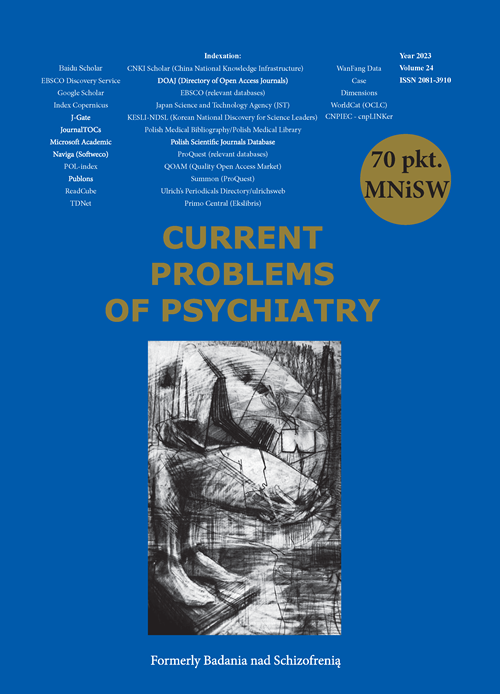The causes, diagnostics, and treatment of psychogenic blindness – a systematic review
DOI:
https://doi.org/10.12923/2353-8627/2023-0023Keywords:
psychogenic blindness, conversion disorders, causesAbstract
Introduction: Conversion disorders are characterized by the presence of motor or sensory dysfunction, resulting in significant discomfort or disability, the occurrence of which is not justified by any somatic disease. Psychogenic blindness, a specific manifestation of conversion disorders, refers to the loss or impairment of vision that cannot be attributed to any organic abnormalities in the eyes or visual system. The exact mechanisms underlying psychogenic blindness are not fully understood, but it is believed to involve complex interactions between the brain, visual pathways, and psychological processes. This systematic review aims to summarize reported cases of blindness in conversion disorders.
Material and methods: A comprehensive search of the MEDLINE and Embase databases identified 13 relevant articles reporting a total of 17 patients with psychogenic blindness.
Results: The risk and triggering factors for psychogenic blindness included acute stress (for example acute physical injury), chronic stressful situations (such as chronic health problems, disruptions in family relationships), and multiple factors including coexisting psychiatric conditions (like anxiety or other conversion disorders). The course of blindness varied among patients, with duration ranging from hours to years. Diagnostic methods involved thorough ophthalmic and neurological examinations, brain imaging, and psychiatric evaluations.
Conclusions: This review provides valuable insights into managing patients with psychogenic blindness. The findings highlight the need for a multidisciplinary approach involving ophthalmologists, neurologists, and mental health specialists. Further research is required to elucidate the underlying mechanisms and develop effective treatment strategies for individuals with psychogenic blindness.
References
1. Galli S, Tatu L, Bogousslavsky J, Aybek S. Conversion, Factitious Disorder and Malingering: A Distinct Pattern or a Continuum? Front Neurol Neurosci. 2018;42:72-80. https://doi.org/10.1159/000475699
2. Prusiński A. Diagnostyka różnicowa zaburzeń czynnościowych i organicznych. Prusiński A, editor. Warsaw: Państwowe Zakłady Wydawnictw Lekarskich; 1974.
3. World Health Organization. International Statistical Classification of Diseases and Related Health Problems 11th Revision 2023 [Available from: https://icd.who.int/browse11/l-m/en.
4. American Psychiatric Association. Diagnostic And Statistical Manual Of Mental Disorders, Fifth Edition, Text Revision 2022 https://doi.org/10.5209/psic.84045
5. Bass C, Halligan P. Factitious disorders and malingering in relation to functional neurologic disorders. Handb Clin Neurol. 2016;139:509-20. https://doi.org/10.1016/b978-0-12-801772-2.00042-4
6. Hallett M, Aybek S, Dworetzky BA, McWhirter L, Staab JP, Stone J. Functional neurological disorder: new subtypes and shared mechanisms. Lancet Neurol. 2022;21(6):537-50. https://doi.org/10.1016/s1474-4422(21)00422-1
7. Peeling JL, Muzio MR. Conversion Disorder. StatPearls. Treasure Island (FL): StatPearls Publishing Copyright © 2023, StatPearls Publishing LLC.; 2023.
8. Gilmour GS, Nielsen G, Teodoro T, Yogarajah M, Coebergh JA, Dilley MD, et al. Management of functional neurological disorder. J Neurol. 2020;267(7):2164-72. https://doi.org/10.1007/s00415-020-09772-w
9. Tsui P, Deptula A, Yuan DY. Conversion Disorder, Functional Neurological Symptom Disorder, and Chronic Pain: Comorbidity, Assessment, and Treatment. Curr Pain Headache Rep. 2017;21(6):29. https://doi.org/10.1007/s11916-017-0627-7
10. Beatty S. Non-organic visual loss. Postgrad Med J. 1999;75(882):201-7.
11. Werring DJ, Weston L, Bullmore ET, Plant GT, Ron MA. Functional magnetic resonance imaging of the cerebral response to visual stimulation in medically unexplained visual loss. Psychol Med. 2004;34(4):583-9. https://doi.org/10.1017/s0033291703008985
12. Moore Q, Al-Zubidi N, Yalamanchili S, Lee AG. Nonorganic visual loss in children. Int Ophthalmol Clin. 2012;52(3):107-23, xii. https://doi.org/10.1097/iio.0b013e31825a1201
13. Stolarska U, Zając A, Skowronek-Bała B, Budziszewska B. Zaburzenia percepcji wzrokowej pochodzenia korowego. Przegląd Lekarski. 2009;66(11):976-82.
14. Vuilleumier P, Chicherio C, Assal F, Schwartz S, Slosman D, Landis T. Functional neuroanatomical correlates of hysterical sensorimotor loss. Brain. 2001;124(Pt 6):1077-90. https://doi.org/10.1093/brain/124.6.1077
15. North CS. The Classification of Hysteria and Related Disorders: Historical and Phenomenological Considerations. Behav Sci (Basel). 2015;5(4):496-517. https://doi.org/10.3390/bs5040496
16. Sabel BA, Wang J, Cárdenas-Morales L, Faiq M, Heim C. Mental stress as consequence and cause of vision loss: the dawn of psychosomatic ophthalmology for preventive and personalized medicine. Epma j. 2018;9(2):133-60. https://doi.org/10.1007/s13167-018-0136-8
17. Mulugeta S, Tesfay K, Frank R, Gruber-Frank C. Acute loss of vision in a young woman: a case report on psychogenic blindness. Ethiop J Health Sci. 2015;25(1):99-104. https://doi.org/10.4314/ejhs.v25i1.13
18. Chung J, Jin KH, Kang J, Kim TG. An atypical presentation of functional visual loss: A case report. Medicine (Baltimore). 2017;96(41):e8292. https://doi.org/10.1097/md.0000000000008292
19. Cutler B, Reed J. Multiple personality. A single case study with a 15 year follow-up. Psychol Med. 1975;5(1):18-26. https://doi.org/10.1017/s0033291700007182
20. Strasburger H, Waldvogel B. Sight and blindness in the same person: Gating in the visual system. Psych J. 2015;4(4):178-85. https://doi.org/10.1002/pchj.109
21. Agarwal HS. Conversion Disorder Manifesting as Functional Visual Loss. J Emerg Med. 2019;57(1):94-6.
22. Gungor S, Aiyer R. Postoperative transient blindness after general anesthesia and surgery: case report of conversion disorder. Pain Manag. 2017;7(5):377-81. https://doi.org/10.2217/pmt-2017-0005
23. Rota E, Gallo A, Papaleo A, Morelli N, Biancardi E. Functional neuroimaging correlates of medically unexplained vision loss. Psychosomatics. 2014;55(2):200-4. https://doi.org/10.1016/j.psym.2013.06.009
24. Parry-Jones WL, Santer-Weststrate HC, Crawley RC. Behaviour therapy in a case of hysterical blindness. Behav Res Ther. 1970;8(1):79-85. https://doi.org/10.1016/0005-7967(70)90038-0
25. Khan AO. Severe psychogenic visual loss in a girl with siblings blinded from congenital glaucoma. J aapos. 2006;10(4):373-4. https://doi.org/10.1016/j.jaapos.2006.01.216
26. Cai Y, Pulido JS. False-positive anti-retinal antibodies as a cause of psychogenic vision loss. Ocul Immunol Inflamm. 2014;22(4):330-2. https://doi.org/10.3109/09273948.2013.836543
27. Laria C, Perez ME, Perez E, Pinero DP, Ruiz-Moreno JM, Aliò JL. Conversion visual loss: a differential diagnosis in infant amblyopia. Eur J Ophthalmol. 2009;19(6):1065-8.
28. Shell MG, Mitchell HL, Loes MW, Belán AP. Conversion disorder presenting in a patient with an implantable morphine pump and an epidural abscess resulting in paraplegia. Arch Phys Med Rehabil. 1997;78(2):226-9. https://doi.org/10.1016/s0003-9993(97)90268-9
Downloads
Published
Issue
Section
License
Copyright (c) 2023 Authors

This work is licensed under a Creative Commons Attribution 4.0 International License.


